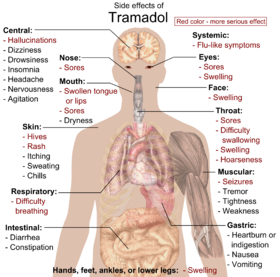Tramadol or Ultram® is a German invented pain reliever created in the 1970s. It is quite different than other prescribed pain relievers like codeine or hydrocodone, and generally considered far less addictive, though people can become addicted to it. The drug has similar action to certain antidepressants, particularly the medication Effexor® which is a selectedserotonin reuptake inhibitor (SSRI). Most often tramadol is prescribed to treat pain associated with various forms of neuralgia. Other conditions for which tramadol might be used are called off-label or investigational and these include restless legs syndrome, migraines, withdrawal of other more addictive medications, fibromyalgia, and obsessive compulsive disorder.
The medication may be a preferred drug for people suffering from chronic pain conditions because it tends to be well tolerated without huge risk of addiction or serious side effects when used appropriately. However, there are dangers, as with any medicine in overusing Ultram®, and many people who stop using the medication suddenly do suffer withdrawal symptoms. Ultram® is a central nervous system depressant and it shouldn’t be used in combination with other things that can depress the central nervous system. Those who take tramadol should avoid using alcohol, taking tranquilizers, or any other medications that can suppress breathing.
Common side effects in regular dosage can include nausea, diarrhea, headache, dizziness, drowsiness and constipation. Withdrawal symptoms if the medication has been taken for a long time can include sweating, anxiety, poor sleep, pain and tremors. If people have taken tramadol for a long period of time, they should work with a doctor to plan safe withdrawal from the medication. Allergy or sensitivity to Ultram® is very rare but may include hives, trouble breathing and dizziness. Symptoms of chest pain, depressed breathing, seizures or rapid heart rate are medical emergencies, but again are extremely rare.
Certain medications are contraindicated when Ultram® is used. It should never be used with other SSRIs (Prozac®, Zoloft®, Paxil®, Luvox® for example) since this can cause a rare complication called serotonin syndrome. Severe cases of this condition may result in seizures and death. As much as having serotonin is a good thing, too much in the body is potentially deadly. Other drugs that hazard some risk of creating serotonin syndrome include monoamine oxidase inhibitors, or first generation antidepressants. When patients take any type of antidepressant they should make sure doctors are aware of this fact before they take tramadol.
Using this medication is also not advised for women who are pregnant or nursing babies. Others who should avoid this drug include those with heart or kidney disease. People with recurrent or chronic breathing conditions should inform doctors prior to taking Ultram®.
Some common drugs lower the effectiveness of tramadol. These include carbamazepine, an anti-seizure medication that is also widely used as a mood stabilizer in patients with bipolar disorder. Quinidine, which regulates heart rhythm, may make the pain fighting action of Ultram® less effective too.
There are several ways to take tramadol. It comes in capsules, tablets, suppositories, and in injectable forms. Some preparations of the medication include other analgesics like acetaminophen or anti-inflammatory agents like aspirin. Recommended dose is usually no more than 400 mg per day. It is especially important to use this medication exactly as prescribed, for the length of time prescribed. It should never be shared with others or used in a manner unadvised by a physician.


No comments:
Post a Comment